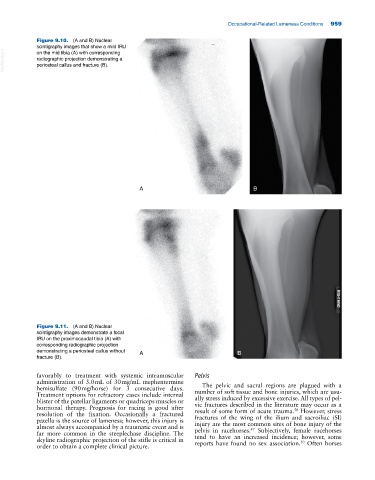Page 993 - Adams and Stashak's Lameness in Horses, 7th Edition
P. 993
Occupational‐Related Lameness Conditions 959
Figure 9.10. (A and B) Nuclear
scintigraphy images that show a mild IRU
VetBooks.ir radiographic projection demonstrating a
on the mid tibia (A) with corresponding
periosteal callus and fracture (B).
A B
Figure 9.11. (A and B) Nuclear
scintigraphy images demonstrate a focal
IRU on the proximocaudal tibia (A) with
corresponding radiographic projection
demonstrating a periosteal callus without A B
fracture (B).
favorably to treatment with systemic intramuscular Pelvis
administration of 3.0 mL of 30 mg/mL mephentermine The pelvic and sacral regions are plagued with a
hemisulfate (90 mg/horse) for 3 consecutive days.
Treatment options for refractory cases include internal number of soft tissue and bone injuries, which are usu
ally stress induced by excessive exercise. All types of pel
blister of the patellar ligaments or quadriceps muscles or
hormonal therapy. Prognosis for racing is good after vic fractures described in the literature may occur as a
50
result of some form of acute trauma. However, stress
resolution of the fixation. Occasionally a fractured
patella is the source of lameness; however, this injury is fractures of the wing of the ilium and sacroiliac (SI)
injury are the most common sites of bone injury of the
almost always accompanied by a traumatic event and is 47
far more common in the steeplechase discipline. The pelvis in racehorses. Subjectively, female racehorses
tend to have an increased incidence; however, some
skyline radiographic projection of the stifle is critical in 50
order to obtain a complete clinical picture. reports have found no sex association. Often horses

